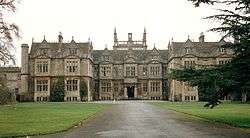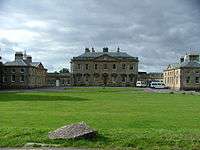Bath School of Art and Design
Former names | Bath School of Art |
|---|---|
| Established | 1852 |
Parent institution | Bath Spa University |
| Location |
Bath, Somerset, United Kingdom 51°23′38″N 2°22′16″W / 51.39377°N 2.371239°WCoordinates: 51°23′38″N 2°22′16″W / 51.39377°N 2.371239°W |
| Website |
artdesign |
Bath School of Art and Design is an art college in Bath, England. It forms part of the Bath Spa University whose main campus is located a few miles from the City at Newton Park, near Corston, Somerset.
History
The school was founded as Bath School of Art in 1852 following The Great Exhibition of 1851.[1] The Bath Directory for 1856 shows its location at Weymouth House (roughly the rear of the present Marks and Spencers store) and its Master as Anthony Carey Stannus, an Irish painter noted for marine scenes and who later helped establish a society which evolved into the Royal Ulster Academy.[2] By the 1858 edition he had been succeeded by John J. Drummond, who by 1860 had set up his own Mr Drummond's School of Art at 3 Bladud Buildings, and later (1862) at 5 Princes Buildings almost opposite.[3]
The original School moved to Hetling House, Westgate Buildings, an ancient building which George Newenham Wright in his Historic Guide to Bath (1864) says had been garrisoned for the Royalists in the Civil War, adding that "the School of Design now occupies the principal and older part".[4] The Master for a few years was John Hill, who later continued as a private tutor and artist at his home in Combe Down until about 1884. The School's syllabus was "in connection with Marlborough House", which meant the Government School of Design and Practical Art.[5]

By 1866 the School was at 33 Paragon, opposite The Star Inn, and the Master was Robert Campbell Puckett, PhD, whose 1871 work "Sciography, or radial projection of shadows" was published by Chapman & Hall of London. The tuition fee was one guinea per quarter according to the school's prospectus published as a one-page advertisement in the annual Directories. Courses were "in connection with the Science and Art Department, South Kensington". A branch was opened at The Corridor for evening classes. Later Head Masters were William Harbutt (1874), the inventor of Plasticine, John Charles Swallow (1878), and Charles M. Hodges (1880). By 1884 William Harbutt was teaching at The Paragon Art Studio, 15 Bladud Buildings.[6]
By 1894 the School had come under the umbrella of the Bath Technical Schools[7] and in April 1896 these occupied the new north extension of the Guildhall, including the retitled School of Art, Art Crafts and Design.[8] The new Head Art Master was Frank Griffin ARCA who had won bronze and silver medals, replaced by Nathaniel Heard ARCA by 1906. By 1912 the Master was Henry Wilkinson ARCA who had been taught by Ruskin and whose son (also Henry) became a well-known engraver. Successors were D.S. (probably Douglas) Andrews ARCA (1920) and Arthur Payne ARCA (1922).
The Technical Schools evolved into the Municipal Bath Technical College[9] which moved to the building in Beau Street vacated by the Royal United Hospital when it moved to Combe Park.[10][11] The process was overseen by the new head art master, the artist Paul Fripp (1934–37).[12] Then came the important appointment of the long serving Clifford Ellis (1937–1972).[13] The School of Art moved to 7 and 8 Green Park early in World War II, when the Beau Street building was taken over by the Admiralty. This new home was totally destroyed by bombs in April 1942, and temporary refuge was found at the home of the artist Walter Sickert at Bathampton. Sickert had been a part-time teacher at the School but had died in January 1942.[14] Clifford Ellis is said to have cut the lettering on Sickert's headstone.
In November 1942 the School began its association with 99 Sydney Place. A note in the local history section of Bath Central Library[15] records the opening of the new premises by Sir Kenneth Clark, then Director of the National Gallery and Surveyor of the King's Pictures.[13] After the war the process began of transforming into Bath Academy of Art-based mainly at Corsham Court, Corsham, and with an initial emphasis on training teachers of art.[1] The nascent City of Bath Training College was first based in another house at Sydney Place before its move to Newton Park, meaning that by 1947 (along with Bath College of Domestic Science then still at Brougham Hayes) all the major components of the future Bath Spa University were now in existence.
The 1983/4 prospectus contained a short history stating that from 1946 the Academy ran two courses at Corsham, one for teacher training and the other a National Diploma in Design with a small intake, with interaction between the two being seen as a particular asset. The Robbins report of 1963 led to more standardised teacher training provision, and the Academy's course was phased out by 1968. The introduction of Art Foundation courses from 1963 onwards led the Academy to begin such a course, based at the Sydney Place site which had been retained for part-time classes for the general public. In 1974 control of the institution passed to the new Avon County Council and from 1 September 1983 the Academy became part of Bath College of Higher Education.
In 1985/6 the Art and Design courses, now of bachelor's degree status, began the process of moving from Corsham to newly converted premises at Sion Hill, Bath, largely vacated by the switch of Home Economics and related courses to new premises at Newton Park.
Curriculum
Courses at the School include Graphic Communication, Creative Art, Fine Art, Digital Design, Fashion and Textile Design, Ceramics and MA Design (Interaction Design, Ceramics, Brand Development or Textiles), Master of Fine Art.
Personalities
Visiting artists and tutors have included Kenneth Armitage, William Scott, Terry Frost,[1] Peter Lanyon, Sir Herbert Read, Adrian Heath, Bernard Meadows, Howard Hodgkin,[1] Anthony Fry, Martin Froy, John Colbeck, John Furnival, Gillian Ayres, Peter Potworowski, Claes Oldenburg,[1] James Greaves, Peter Kinley, James Tower, John Hoskin, Mark Lancaster, Michael Craig-Martin,[1] John Ernest,[1] Anthony Hill, Richard Hamilton, Roger Clarke,[1] Adam Burton, Jim Dine,[1] Tom Phillips, Jeremy Gardiner and Morton Feldman
Notable alumni
- Roger Deakins, cinematographer[16]
- Laura Ford, artist[17]
- William Harbutt, artist[18]
- Salima Hashmi, artist[19]
- Howard Hodgkin, artist[20]
- Donald Locke, artist[21]
- Leila Locke, artist[22]
- John O'Neill, video game designer[23]
- Edward Piper, painter[24]
- Peter Randall-Page, artist[25]
- Axel Scheffler, illustrator[26]
- Judith Trim[27]
References
- 1 2 3 4 5 6 7 8 9 "Introduction – Bath Spa University". The Saatchi Gallery. Retrieved 12 December 2010.
- ↑ "Featured person- Anthony Carey Stannus (1830–1919) Artist". Ulster History Circle-Dictionary of Ulster Biography. Retrieved 17 November 2010.
- ↑ "Post office Bath Directory". Page 310 Princes Buildings. Historical Directories. 1864. Archived from the original on 13 November 2010. Retrieved 15 November 2010.
- ↑ "Post office Bath Directory". Page 831 Hetling Court School of Art. Historical Directories. 1864. Archived from the original on 13 November 2010. Retrieved 15 November 2010.
- ↑ "Post office Bath Directory". Page 493 Bath School of Art Master John Hill. Historical Directories. 1864. Archived from the original on 13 November 2010. Retrieved 15 November 2010.
- ↑ "Post office Bath Directory". Page 125 Harbutt William-artist and teacher-The Paragon Art Studio. Historical Directories. 1884. Archived from the original on 13 November 2010. Retrieved 15 November 2010.
- ↑ Bath Central LibraryKelly's Directory. 1897. p. 45.
- ↑ "Plan for sites adjoining the Guildhall (Technical Schools) 14 March 1891". Central Library Collection. Bath in Time. Retrieved 17 November 2010.
- ↑ "Plan of Technical Schools (first floor) 1932". Central Library Collection. Bath in Time. Retrieved 17 November 2010.
- ↑ A potted History of the RUH Retrieved 17 November 2010
- ↑ Medical Heritage Retrieved 17 November 2010
- ↑ "Paul Fripp". The Fripp & Pocock families. Retrieved 12 December 2010.
- 1 2 Pope, Derek. "A celebration of Bath Academy of Art" (PDF). Bath Academy of Art. Archived (PDF) from the original on 6 January 2011. Retrieved 12 December 2010.
- ↑ "Odds and quads". Times Higher Education. Retrieved 12 December 2010.
- ↑ "Bath Central Library" (PDF). National archives NRA 25737. nationalarchives.gov.uk. Retrieved 22 November 2010.
- ↑ Internet Movie Database. Retrieved 18 November 2010
- ↑ ArtNet Retrieved 18 November 2010
- ↑ Victoria Art Gallery. Retrieved 18 November 2010
- ↑ Salima Hashmi
- ↑ Victoria Art Gallery Retrieved 18 November 2010
- ↑ Iniva website. Retrieved 23 October 2016
- ↑ Claudette Earl, Leila Elizabeth Locke - an appreciation, Chronicle Family Magazine, April 19, 1992.
- ↑ Forman, Tracie. "Inside Gaming – John O'Neill: The Dali of Computer Gaming." Electronic Games. Vol.2, No.13. Pp.64–65. July 1984. ISSN 0730-6687.
- ↑ Tate Gallery. Retrieved 18 November 2010
- ↑ Tate Collection. Retrieved 18 November 2010
- ↑ The Observer Retrieved 18 November 2010
- ↑ Cooper, Emmanuel (25 January 2001). "Judy Trim". The Independent. Archived from the original on 3 October 2010. Retrieved 14 October 2010.
External links
- Bath School of Art and Design Website
- Information and links for past students/staff at Bath Academy of Art/Corsham Court: including images and reunions

